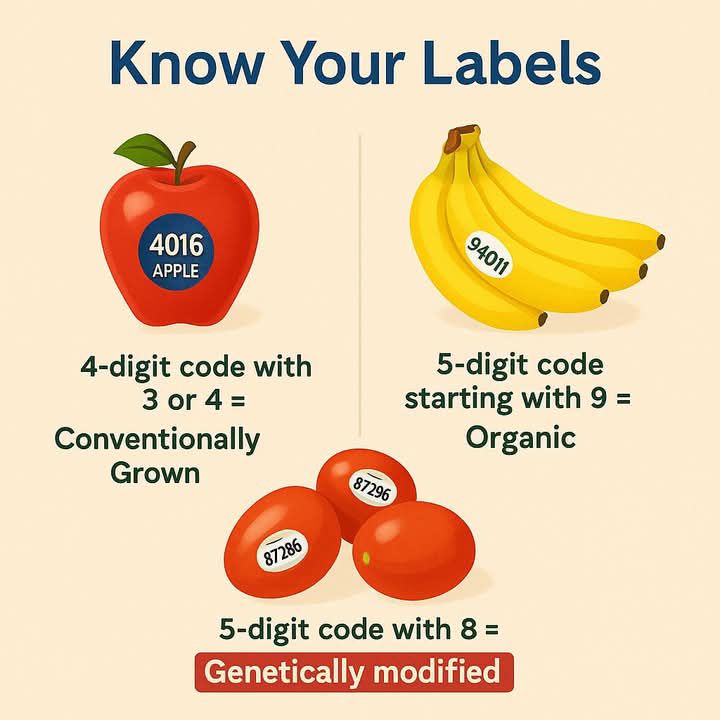When you go to the grocery store, it’s easy to grab a piece of fruit or vegetable without paying much attention to the sticker placed on it. However, understanding the PLU (Price Look-Up) code on these stickers can give you valuable information about how the produce was grown. PLU codes indicate whether the produce is conventionally grown, organically grown, or genetically modified (GMO). By decoding these codes, you can make more informed choices and purchase produce that aligns with your values and health preferences.
What are PLU Codes?
PLU codes are numerical identifiers used by grocery stores and markets to identify and price individual items. These codes, ranging from 4 to 5 digits, are placed on produce items to make checkout easier and faster. They are a part of the global PLU system maintained by the International Federation for Produce Standards (IFPS). While the primary function of PLU codes is to make shopping more efficient, they also provide insight into how a particular piece of produce was grown, whether it’s been genetically modified, or if it’s certified organic.
In this guide, we’ll break down the different types of produce stickers and how to read them effectively.
1. Conventionally Grown Produce
PLU Code: 4-digit number (e.g., 4012)
Example: Apple with code 4012
Meaning: Conventionally grown produce is cultivated using synthetic chemicals, pesticides, and fertilizers. While these farming methods are highly effective in ensuring large yields and protecting against pests, they can have environmental and health implications over time.
Sticker Appearance: The sticker on conventionally grown produce has a simple, 4-digit number with no special prefix.
Consumer Tip:
Conventionally grown produce is the most common type of produce available at grocery stores. While it’s generally more affordable than organic options, the presence of pesticides and synthetic fertilizers could be a concern for some consumers. This type of produce is not organic and may be treated with chemical inputs, which can have long-term environmental consequences. Conventional farming often involves the use of herbicides and insecticides that may leave residues on fruits and vegetables, even after washing.
Choosing conventionally grown produce is an option for people who are on a budget or may not prioritize organic farming. However, consumers who wish to avoid synthetic chemicals may want to look for other options. Washing produce thoroughly can help reduce some of the pesticide residues, but it may not eliminate all traces.
2. Organically Grown Produce
PLU Code: 5-digit number starting with 9 (e.g., 94011)
Example: Banana with code 94011
Meaning: Organic produce is grown without the use of synthetic pesticides, fertilizers, or genetically modified organisms (GMOs). Organic farming practices focus on sustainability, soil health, and ecological balance. These methods use natural fertilizers like compost or manure, and farmers rely on biological pest control methods instead of synthetic chemicals.
Sticker Appearance: Organic produce stickers will show a 5-digit code, with the first digit being a “9.” For example, organic bananas might be labeled as 94011, where “9” denotes the organic status, and the remaining four digits correspond to the produce item.
Consumer Tip:
If you’re looking to avoid synthetic chemicals and pesticides, organic produce is the best choice. Organic farming practices typically rely on crop rotation, natural pest control, and composting, which not only improves the health of the soil but also reduces the environmental impact. Furthermore, organic produce is free from GMOs, which may be important for consumers who want to avoid genetically modified foods.
While organic produce is often more expensive due to the more labor-intensive farming practices, many consumers are willing to pay a premium for the assurance that their food is grown sustainably and without harmful chemicals. For people with concerns about pesticide residues or the impact of conventional farming on the environment, choosing organic is a great alternative.
3. Genetically Modified (GMO) Produce
PLU Code: 5-digit number starting with 8 (e.g., 88039)
Example: Tomato with code 88039
Meaning: GMO produce is made through genetic engineering, which involves altering the plant’s DNA to achieve desired traits, such as increased resistance to pests, herbicides, or diseases. While genetic modification can lead to higher yields and reduced pesticide use, it has raised concerns regarding potential long-term health effects, environmental impact, and ethical considerations.
Sticker Appearance: GMO produce typically has a 5-digit code beginning with the number “8.” For example, genetically modified tomatoes might be labeled as 88039, where the “8” signals that the produce is GMO, and the remaining digits are used to identify the type of produce.
Consumer Tip:
While genetically modified foods are less common in many markets, some produce items are genetically engineered for specific traits. Common genetically modified crops include corn, soybeans, and some varieties of tomatoes, papayas, and squash. The debate surrounding GMOs continues, with critics expressing concerns about their safety for human consumption, as well as the potential for unintended environmental consequences.
One of the main reasons for genetically modifying crops is to improve resistance to pests and diseases, as well as to enhance the shelf life and nutritional value of the produce. While GMO crops have been deemed safe by regulatory agencies like the FDA, many consumers choose to avoid them due to ethical or environmental reasons. For those who are concerned about GMOs, it’s important to read the PLU code carefully and opt for organic produce or items with a PLU code that doesn’t begin with “8.”
4. Additional Tips for Identifying Produce Stickers
Here are a few extra things to keep in mind when reading produce stickers:
No Prefix: A 4-digit code with no prefix indicates conventional, non-organic produce.
Prefix “9”: If the PLU code begins with a “9,” the produce is organic and grown without synthetic chemicals.
Prefix “8”: A PLU code that begins with an “8” indicates that the produce is genetically modified.
Read the Digits: The rest of the code, after the prefix, is used to identify the specific type of produce. Each fruit or vegetable has a unique 4-digit number. For example, apples are often labeled with codes like 4011 or 94100, where the first number represents the type (e.g., “4” for conventional or “9” for organic apples), and the following digits represent the specific variety.
Why Does It Matter?
By understanding PLU codes, you are empowered to make more informed choices about your food. Knowing whether the produce is conventionally grown, organic, or genetically modified helps you take control of your food purchasing decisions. For many people, selecting organic produce is a priority because of health or environmental concerns. On the other hand, some consumers may not have issues with GMOs and prefer conventional produce for its affordability.
Understanding PLU codes also allows you to stay informed about the types of pesticides and chemicals that might have been used in the farming process. For consumers who prioritize sustainability, choosing organic produce can support farming practices that minimize harm to the environment and reduce exposure to potentially harmful chemicals.
Conclusion: Be Informed When You Shop
The next time you’re in the produce section, take a moment to examine the PLU codes on the stickers. Whether you’re selecting apples, bananas, tomatoes, or any other produce item, the code will tell you more than just the price. It will reveal whether the item was grown conventionally, organically, or genetically modified. Armed with this knowledge, you can make decisions that reflect your values and preferences, helping you buy food that supports your health, lifestyle, and environmental goals.
By understanding the PLU system, you’ll be able to navigate the grocery store more confidently, knowing exactly what you’re purchasing and how it was produced. Whether you’re aiming to buy pesticide-free, organic produce or you’re just trying to get the best deal on conventionally grown fruits and vegetables, PLU codes provide the clarity you need to make the best choices for your kitchen and beyond.
More Articles You Might Like
-
Texas Toast Sloppy Joes: The Crunchy, Cheesy Upgrade You Didn’t Know You Needed
There’s something timeless about sloppy joes. For generations, this saucy, savory, and slightly sweet ground beef sandwich has been a go-to comfort food in American kitchens. It’s quick, filling, and family-friendly—perfect for busy weeknights. But what if we told you there’s a way to take this classic dish up a notch? Enter the Texas Toast…
-
Classic Pig Pickin’ Cake
When it comes to Southern desserts, few sweets shine as brightly as the Classic Pig Pickin’ Cake. This nostalgic cake, sometimes called a “Mandarin Orange Cake,” has roots deep in Southern tradition. It gets its playful name from its frequent appearance at pig pickin’s—Southern-style barbecue gatherings where communities come together to enjoy slow-cooked pork, sides,…
-
Lemon Garlic Butter Chicken with Creamy Parmesan Pasta
There’s something irresistible about the combination of tender, golden-browned chicken paired with a creamy pasta coated in Parmesan cheese. Add the brightness of lemon, the depth of garlic, and the richness of butter, and you have a recipe that feels indulgent yet approachable enough for a weeknight dinner. Lemon Garlic Butter Chicken with Creamy Parmesan…



